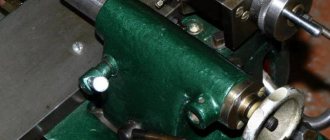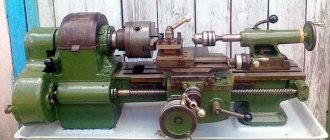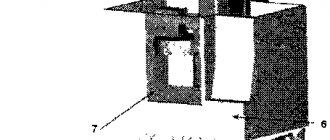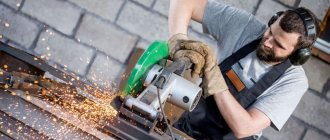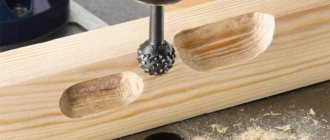Using a lathe of one of the modern models, you can perform a fairly large list of technological operations for metal processing. But mainly such equipment is used to process the external and internal surfaces of workpieces having a cylindrical, conical and shaped configuration.
Modern lathe
Classification of lathes
According to the classification of metal-cutting equipment, turning equipment is divided into:
- Single-spindle and semi-automatic machines
- Multi-spindle and semi-automatic machines
- Revolving
- Drilling and cutting
- Lobototurny
- Multi-cutting (screw-cutting)
- Specialized
- Various lathes
- Carousel
Specialized automatic and semi-automatic machines are used for the manufacture of parts that require unique processing; the operation of the machine is partially or fully automated. Semi-automatic machines cannot independently load and unload parts with workpieces; this operation is performed by the operator.
Single-spindle and semi-automatic machines are used for complex processing in large-scale production.
- Multi-spindle and semi-automatic machines. Several workpieces are fixed on the spindle block, after which they are moved one by one to the working position, and they are processed using several tool groups.
- Turret machines are fundamentally special in that they have a rotating head in which everything necessary is fixed, thereby saving processing time.
- Drilling and cutting equipment is designed for synchronous cutting and drilling of volumetric workpieces.
Lathe turning equipment is designed for turning short workpieces of large diameters. It is possible to process workpieces of uneven diameters thanks to independent cams on the faceplate. Quite rarely found in production due to a number of disadvantages, such as low accuracy and productivity.
Screw-cutting lathes are the most recognizable equipment of the turning group. It can be used for turning, drilling, and end processing. Additional functions include thread cutting and cone turning.
Specialized machines are necessary for the manufacture of parts of a narrow range.
Rotary machines are simply irreplaceable when processing large workpieces of short length. Due to their high precision, rotary lathes have almost completely replaced lobot lathes. The horizontal position of the faceplate determines the operating features of the equipment.
Code of turning machines
When designating the code for machines in a turning group, the first digit 1 indicates the group of machines. The second number indicates the type of lathe. The subsequent numbers, as a rule, show the technological parameter of the machine, namely: the maximum diameter of the workpiece, the height of the centers, etc. The letter after the first or second code can symbolize the generation of the machine, the manufacturer or modification. The letter placed at the end of the digital code may indicate an improvement in the base model or the accuracy class of the machine.
Here are some examples of the designation of lathe models.
1K62 - number 1 - group of lathes; 6 — turning and wine-cutting machine; 2 — height of centers, dm; letter K - generation.
1A616 - figure - group of lathes; 6 — screw-cutting lathe; 16 — height of centers, cm; A - generation.
1B811 - number 1 - group of lathes; 8 — turning and backing; 1 - technological parameter that determines the dimensions of the workpieces being processed; B - generation.
16K20P - number 1 - group of lathes; 6 — turning screw-cutting; 20 — height of centers, cm; K - generation; P - accuracy class - increased.
It should be noted that the sixth type of machines includes screw-cutting lathes, and the eighth type includes backing lathes. In the machine tool industry, the majority of manufactured metal-cutting machines, including lathes, are manufactured according to state standards; in which the main parameters correspond to normal or size ranges. By dimensional or normal series we mean a group of similar machines, consisting mainly of standardized units and parts, each of which is designed for processing parts of certain sizes,
The size ranges (standard sizes) of universal screw-cutting lathes and two-column rotary lathes are given in table. 1.
Table 1.
The table shows that the main parameter that determines the standard sizes of machines is the dimensions of the installed part. Moreover, each subsequent standard size of the machine makes it possible to process a part with a diameter 1.26 times larger than that of the previous part. Thus, for universal screw-cutting lathes and rotary machines, the denominator of the size range is set to 1.26. In other words, the series of numbers is 250; 320; 400; 500; 630; 800; 1000 (2300; 3200; 4000; 5000; 6300; 8000) form a geometric progression with a denominator of 1.26.
The maximum height of the installed part on rotary machines also changes according to the law of geometric progression with a denominator equal to 1.26: 2000, 2500, 3200. The presence of two naturally changing main parameters: the largest diameter of the installed part and its heights makes it possible to also regularly change other technical characteristics machine: power of the main drive, weight of the installed part, etc.
According to the degree of specialization, all machines are divided into universal, specialized and special.
Universal machines are machines that can perform various operations on a wide range of parts.
Specialized are machines that can perform a limited number of operations on parts of the same type.
Special machines are machines designed to perform a limited number of operations on parts of one standard size.
Lathe device
Lathes consist of the following structural elements:
- Bed – the main part of the machine on which all components and mechanisms are located;
- An apron that converts the movement of the drive shaft or screw into the longitudinal movement of the caliper;
- A support where the cutting tool is secured;
- Feed box, which communicates movement from the drive shaft or screw to the caliper;
- An electric motor that provides the machine with electricity;
- The spindle head, which houses the spindle of the machine.
Industrial equipment
From among the standard fuel assemblies of the industrial group, you can select an option for both the workshop and the experimental workshop. The discreteness of the stroke and the permissible error are regulated by standards. The operation of components and mechanisms is ideal with the established maintenance procedure. The difficulty of choice lies in a thorough comparison of the capabilities of a standard machine and the expected operating features. Minor modifications are allowed. If there are obvious non-conformities, upgrading must be carried out by the manufacturer. Optimally – fuel assemblies made to order.
Stalex GH-1430B – from RUB 540,611.
The oil bath of the gearbox, from which the headstock bearings are lubricated, and the rigidity of the structure bring the domestically developed product as close as possible to the high standard of older FA models.
The advantage of the younger machine is the error declared by the manufacturer of 0.005 mm. Considering the features of service and the stated cost, I can confidently say that equipment with such precision should be classified as industrial. Which, despite its average dimensions, will be effectively used only in the conditions of a production and experimental workshop. Characteristics of Stalex GH-1430B
| Characteristic | Meaning |
| Permissible diameter of the workpiece above the bed, mm | 330 |
| Distance between centers, mm | 750 |
| Spindle through hole diameter, mm | 38 |
| Speed, rpm | 70 — 2000 |
| Weight, kg | 510 |
| Features of the basic configuration |
|
| Homeland of the brand | Russia |
Proma SPF-2000PH – from RUB 1,220,000.
For drilling, reaming holes, grinding parts and rolling corrugations on the scale of repair and locksmith shops of large enterprises, accurate and powerful machines are required. The Czech version with a 2-meter working surface of the bed, a 5.5 kilowatt electric motor and a hydraulic station for supplying lubricating and cooling fluid meets all the requirements for industrial equipment. 2 steady rests on the bed increase the efficiency of processing large-sized workpieces. Maintenance of Proma SPF-2000PH requires certain qualifications from personnel. Therefore, at enterprises, the replacement of process fluids and local repairs are entrusted to highly specialized specialists. I recommend entrusting the first commissioning work to specialists from the manufacturer. Characteristics of Proma SPF-2000PH
| Characteristic | Meaning |
| Permissible diameter of the workpiece above the bed, mm | 460 |
| Distance between centers, mm | 2000 |
| Spindle through hole diameter, mm | 80 |
| Speed, rpm | 25 - 1800 (12 speeds) |
| Weight, kg | 3055 |
| Features of the basic configuration |
|
| Development/production | Czech |
Jet GH-2040 ZH DRO RFS – from RUB 1,165,000.
The index “2040” in the TVS marking identifies the junior model of the senior line of standard lathes of the GH ZH DRO RFS series, from the international corporation JET.
The differences between each of the 4 options are in the dimensions of the equipment and the maximum length of the workpiece. The motor is 12 kW, the parameters of each of the 4 possible thread options, the rotation speed of the feed shaft for the GH ZH DRO RFS models are completely identical. Which allows us to conclude about the impressive potential of fuel assemblies with code 2040. Characteristics of JET GH-2040 ZH DRO RFS
| Characteristic | Meaning |
| Permissible diameter of the workpiece above the bed, mm | 500 |
| Distance between centers, mm | 1015 |
| Spindle through hole diameter, mm | 80 |
| Speed, rpm | 9 – 1600 (24 positions) |
| Weight, kg | 2750 |
| Features of the basic configuration |
|
| Development/production | Switzerland/SEA, Europe |
A detailed review of the model - issues from configuration to the hardness of the frame are considered; Maximum cut per revolution tested:
What causes injuries?
Factors that pose a threat to humans include:
- Spindle rotation
- Chips flying during processing
- Coolant splashes
- Machine voltage
- Sharp burrs on workpieces
Each worker is given instructions that describe all the points regarding the rules of behavior when operating the equipment. Operators are required to comply with all requirements.
General provisions
Persons who have completed all introductory instructions, fire safety instructions, and safety instructions are allowed to work on a lathe.
- Working on a lathe is impossible without special clothing. Headgear and safety glasses are required.
- Women are required to hide their hair under a headdress, however, this also applies to men.
- Hair should be styled in such a way as to exclude any possibility of it coming into contact with the rotating mechanisms of the machine.
Important! It is forbidden to use gloves while working, as threads protruding from them can get caught in the rotating chuck, which will lead to injury to the operator. The worker is also required to fasten all buttons on his sleeves for the same reasons.
The machine must be grounded and fixed. If it is being repaired, there should be a corresponding sign on it.
Activities not related to work are prohibited in the workplace: smoking, eating, using a mobile phone.
Workers under the influence of alcohol or drugs are not allowed to work on a lathe. Workers who are taking medications that slow their reactions are also not allowed.
History of the appearance and development of equipment
According to historians, lathes (or rather, the primitive ancestors of such devices) were invented and began to be used by man in the middle of the 7th century BC. Of course, such a device had a simple design, but it made it possible to effectively process wood or bone products. In order to carry out such processing, the part was clamped in two centers, which were mounted coaxially with each other. It was rotated manually, and the cutting process was carried out using a hand cutter, which was manipulated by a separate “operator”. Thus, the product was given the required shape and size.
The next stage of development that the equipment of the turning group underwent was equipping it with a drive necessary to impart rotational movement to the part. Initially, a bow string was used as such a drive, which was looped over the workpiece. And a little later (in the 14th century) a foot drive for turning equipment was invented.
Antique foot operated lathe
The design of such a drive, very reminiscent of the drive mechanism of a foot sewing machine, consisted of a fixed cantilever wooden pole connected to the workpiece using a strong rope. When you pressed the pole with your foot, the rope was stretched, which led to the rotation of the workpiece by 1–2 turns. After the leg was removed from the pole, the rope was released and rushed upward, which entailed the rotation of the workpiece in the other direction.
Despite their simple design, such lathes already made it possible to perform processing with fairly high quality. Their advantage was that servicing the devices was very simple.
A. Nartov's turning and copying machine, 1729
The lathe of the 16th century group already had a steady rest and centers made of metal in its design, which made it possible to use it for processing workpieces with complex configurations. However, due to the low power of such a device, it was not yet possible to use it for turning metal workpieces.
The history of the lathe received a strong impetus in the 1700s, when the Russian Andrei Nartov created a device on which a mechanical support was installed. It should be noted that it was this innovation that served as the strongest impetus for the development of all equipment designed for processing metal workpieces. A major contribution to the development of turning units was made by French engineers, who by the middle of the 18th century created a device that was highly versatile. By the end of this century, French industry began to use a specialized unit on which it was possible to cut threads on metal screws.
Maudsley Lathes (click to enlarge)
The year 1794 is considered to be a truly breakthrough in the development of turning equipment, when Henry Maudsley created a machine that served as the basis for the further development of all turning units. What is noteworthy is that the company founded by Maudsley was also engaged in the production of dies and taps, with the help of which threads were cut on his equipment.
They began to think about automating a lathe in the 19th century, and American engineers took the lead in this matter. This process followed the path of equipping units with additional automation elements, which ultimately led to the creation of the first machine with a turret. It was on the basis of such devices that later they began to create universal automatic machines, the first of which (the Spencer machine) was presented to the public in 1973.
During work
Safety precautions when operating the equipment:
- Securely secure workpieces;
- Remove chips in a timely manner using a special hook and prevent them from wrapping around the part;
- Monitor the proper operation of the machine; in case of deviation, stop work immediately;
- Support long parts either with movable supports (rests) or with a tailstock
Important! It seems stupid, but before work you MUST remove the key from the socket.
Prohibited:
- Touch the part with your hands or foreign objects;
- Work with gloves
- Try to fix equipment failure yourself;
- Cool parts with a damp cloth;
- Getting distracted while working;
- Transmit anything through operating equipment;
- Leave the machine running unattended.
After work
Upon completion of equipment operation, you must:
- Turn off the power;
- Clean the machine and the space around it from chips and liquids;
- Place tools, workpieces and parts;
- In the event of a breakdown, report it to management;
- Wash your hands and face thoroughly, take off your overalls.
Tips for choosing
When choosing a lathe, it is necessary to take into account the material being processed, its dimensions, the dimensions of the machine and, of course, the budget. A small-sized screw-cutting lathe with low power is suitable for a garage.
For production, it is recommended to take a closer look at more powerful and versatile equipment.
It is also recommended that when purchasing a machine, you carefully inspect it for cracks, breakages, abrasions, and so on.
Woodworking machines
Modern manufacturers offer a wide selection of woodworking machines. General-purpose installations, special models for the production of similar parts, or specialized devices for certain types of wood processing are produced.
To ensure that the equipment fully meets your expectations after purchase, we suggest using the following tips.
- Optimal power depends on the characteristics of the work and the list of operations that will be performed on the selected machine. Household models are considered to be models with a power of up to 3 kW/h, connected to a 220 V network; industrial models are units with higher productivity, which are also distinguished by a greater depth of cut, planing width, and a wider range of functions.
- The bed should be heavy and rigid (cast iron would be the ideal material for its manufacture).
- It is desirable to have a chuck on the headstock or the ability to install it. In the future, this will make it possible to process workpieces that are secured at only one end.
- The ability to install a drill chuck on the tailstock, which will greatly facilitate the task of sharpening blind holes.
- The presence of a spindle speed controller is a convenient feature that will help improve the quality of many technological operations.
- Universal models are equipped with a saw blade, drill, milling cutter, planing shaft with 3 or 4 knives.
Regardless of the type of lathe chosen, its parameters and technical characteristics, special attention should be paid to the quality of its assembly and the manufacturer’s use of materials that can withstand the planned loads. Universal multifunctional modifications always become the optimal solution: with the help of such a machine it becomes possible to solve almost any problem in metal or wood processing.
Show prices for lathes
Rating of the best machines
| Place | Model | Advantages | Flaws |
| 1 | JET GHB-1330A DRO | Versatility Reliability Easy to set up Digital display system | High price |
| 2 | STALEX C0632D/1000 | Multifunctionality High accuracy Comfortable | High price |
| 3 | METALMASTER MML 2870M (15461) | Operates from 220V Multifunctionality Smooth adjustment of the router | There is no lubricating fluid supply system |
| 4 | JET BD-12G 220B 50000913M | High quality performance Safety Automatic feeding Reliability | High cost Small set of available functions |
| 5 | JET BD-X7 50000900MX | Compact and lightweight Availability of longitudinal feed automation Good accuracy | No lubricant supply system Manual cross feed |
| 6 | STALEX D250X400C | High quality performance Availability of a protective screen High accuracy | Heavy for its size Manual cross feed |
| 7 | CALIBER STMN-550/350 | Cheap Small dimensions Almost silent | Poor build quality |
Small Business Equipment
The selection of fuel assemblies for a production or repair business project is always carried out taking into account the inevitable modernization for similar tasks. There are no problems with processing precision for equipment in this category. Wear resistance is also at the level. But some manufacturers rely on the universal potential, others on the dimensions of the machine’s working area. Identify your main tasks and look for a machine to implement them. Then the purchase of a new fuel assembly will not affect the profitability of the business.
Proma SKF-800 – from RUB 272,365.
The combination of milling and screw-cutting devices within one lathe turned out to be one of the best solutions of the Czech Proma SKF-800.
The rotary drilling unit and the impressive diameter of the hole in the spindle allow you to work with fairly large parts. 2 identical three-phase motors guarantee sufficient torque for each device. A worthy option for those who plan to engage in professional activities in a small workshop. The only design flaw is the lack of tight contact of the protective panels with the frame. Because of this, chips and lubricants can cause rapid wear of the drive mechanisms. The manufacturer recommends that exposed parts be thoroughly cleaned and lubricated twice a day. I recommend checking the belt tension during each maintenance break. Characteristics of Proma SKF-800
| Characteristic | Meaning |
| Permissible diameter of the workpiece above the bed, mm | 420 |
| Distance between centers, mm | 750 |
| Spindle through hole diameter, mm | 28 |
| Speed, rpm | 160 -1360 (7 steps) |
| Weight, kg | 230 |
| Features of the basic configuration |
|
| Homeland of the brand and country of origin | Czech |
Video from the manufacturer Proma, the video shows the performance characteristics and reveals the functionality of the machine:
MetalMaster X32100 – from RUB 284,970.
Thread indicator, digital display device, longitudinal and transverse automatic feed system; supply of lubricant and cooling fluid - a machine from MetalMaster simplifies the process of metal processing without loss of quality. Professionals often compare the functionality of this machine with Soviet equipment of a similar profile. I consider such analogies to be incorrect - apart from a certain set of functions, nothing connects them.
- X32100 removes 3 mm chips in one pass
- Discretion of carriage stroke in any direction – 0.001 mm
- MetalMaster provides the opportunity to reduce equipment costs by 12% by eliminating the digital display device (12% of the cost).
With such a ratio of potential, compact dimensions, ergonomic controls and 1 year of official warranty, this machine has no competitors in the price segment up to 300,000.
Characteristics of MetalMaster X32100
| Characteristic | Meaning |
| Permissible diameter of the workpiece above the bed, mm | 330 |
| Distance between centers, mm | 1000 |
| Spindle through hole diameter, mm | 38 |
| Speed, rpm | 65 - 1810 (18 speeds) |
| Weight, kg | 520 |
| Features of the basic configuration |
|
| Development/production | Russia/countries of Southeast Asia (SEA) |
The video shows the machine in operation - the thread cutting process on this unit is demonstrated. In principle, everything is done easily, and special training is not needed at all to work on this machine:
Jet GHB-1330A – from RUB 350,000.
The scope of use of this fuel assembly is small-scale production and piece products.
Weight, length of the frame and a small basic set of accessories indicate the professional orientation of the equipment. That is, when the necessary equipment is purchased as needed to perform specific tasks. Having experience working on this machine, I can say that in addition to convenient control and actual power, the length of the bed or the width of the through hole of the spindle is definitely not enough. Changes had to be made to the order for meter-long spatial structure elements made from a 50-millimeter pipe at the discussion stage. If the specifics of the work are not related to the maintenance of construction sites, then this machine will be a justified investment in the development of your business. Characteristics of JET GHB-1330A
| Characteristic | Meaning |
| Permissible diameter of the workpiece above the bed, mm | 330 |
| Distance between centers, mm | 760 |
| spindle through hole diameter, mm | 38 |
| Speed, rpm | 70 - 2000 (8 speeds) |
| Weight, kg | 600 |
| Features of the basic configuration |
|
| Development/production | Switzerland/SEA, Europe |
Detailed video review of the model. The author provides the performance characteristics of the machine, its functionality, and demonstrates it in operation:






